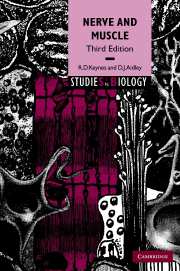Book contents
- Frontmatter
- Contents
- Preface
- Publishers note
- 1 Structural organization of the nervous system
- 2 Resting and action potentials
- 3 The ionic permeability of the nerve membrane
- 4 Membrane permeability changes during excitation
- 5 Voltage-gated ion channels
- 6 Cable theory and saltatory conduction
- 7 Neuromuscular transmission
- 8 Synaptic transmission in the nervous system
- 9 Skeletal muscles
- 10 The mechanism of contraction in skeletal muscle
- 11 Non-skeletal muscles
- Further reading
- References
- Index
3 - The ionic permeability of the nerve membrane
Published online by Cambridge University Press: 05 June 2012
- Frontmatter
- Contents
- Preface
- Publishers note
- 1 Structural organization of the nervous system
- 2 Resting and action potentials
- 3 The ionic permeability of the nerve membrane
- 4 Membrane permeability changes during excitation
- 5 Voltage-gated ion channels
- 6 Cable theory and saltatory conduction
- 7 Neuromuscular transmission
- 8 Synaptic transmission in the nervous system
- 9 Skeletal muscles
- 10 The mechanism of contraction in skeletal muscle
- 11 Non-skeletal muscles
- Further reading
- References
- Index
Summary
Structure of the cell membrane
All living cells are surrounded by a plasma membrane composed of lipids and proteins, whose main function is to control the passage of substances into and out of the cell. In general, the role of the lipids is to furnish a continuous matrix that is impermeable even to the smallest ions, in which proteins are embedded to provide selective pathways for the transport of ions and organic molecules both down and against the prevailing gradients of chemical activity. The ease with which a molecule can cross a cell membrane depends to some extent on its size, but more importantly on its charge and lipid solubility. Hence the lipid matrix can exclude completely all large water-soluble molecules and also small charged molecules and ions, but is permeable to water and small uncharged molecules like urea. The nature of the transport pathways is dependent on the specific function of the cell under consideration. In the case of nerve and muscle, the pathways that are functionally important in connection with the conduction mechanism are (1) the voltage-sensitive sodium and potassium channels peculiar to electrically excitable membranes, (2) the ligandgated channels at synapses that transfer excitation onwards from the nerve terminal, and (3) the ubiquitous sodium pump which is responsible in all types of cell for the extrusion of sodium ions from the interior.
- Type
- Chapter
- Information
- Nerve and Muscle , pp. 25 - 40Publisher: Cambridge University PressPrint publication year: 2001

